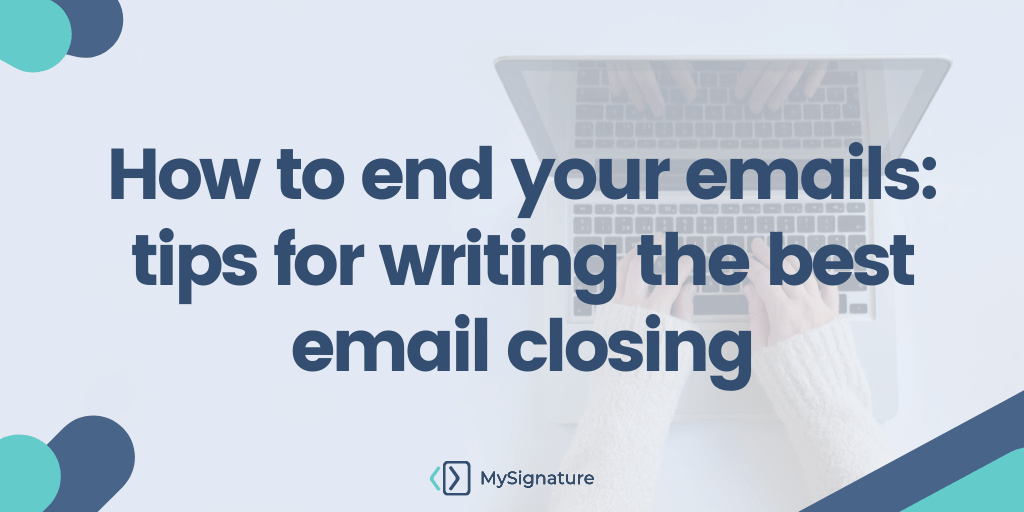You can end your email either with a usual sign-off or an email signature. Both options are good if you write them correctly. However, whether you write a formal business correspondence or an informal email, you should always try to finish it politely to get a recipient on your side and make the email warmer. I have collected some tips for professional email ending occasionally in this blog post.
Ways to end an email
85% of communication in the office goes via email, and a typical employee sends approximately 15,000 emails a year. It is already well-known that compared to all marketing channels, the highest open rate can be achieved through emails.Sure thing, we are talking about business emails. If you reach out to some close friend, the email closing line doesn’t bear any power. You already know the person and can anticipate their reaction. It is a warm email. While most business emails are cold, each element, including the closing, may be crucial for building relationships with the recipient.
Examples of how to close an email
If you write an email to a person you do not know, your manager, or someone in a high position, your email and the sign-off should be formal. The following variations are applicable: regards, best regards, warm regards, best, respectfully, yours truly, best wishes, cordially, looking forward to your reply, looking forward to hearing from you, sincerely, sincerely yours, faithfully.
You can stick to a friendly tone if you know the person well. A casual, less formal (informal) email ending will work even if you email your colleague. In this case, choose informal sign-off from the list: good luck, talk soon, cheers, best of luck, hope this helps, have a good weekend, much appreciation, appreciate it.
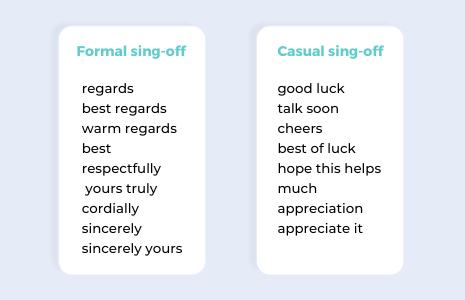
There might be situations when you have to reply to an email where someone offers you something. Or if you need to ask for a favor or thank someone for helping you, use any of the following appreciation email closings: thanks for everything, thanks, thank you in advance, thank you, thanks so much, thank you for your help, thank you for consideration, with gratitude, thanks so much, can’t thank you enough.
An interesting fact is that emails that end with different “thank you” variations have the highest response rate. Bloomberg reported that emails with such sign-offs as thanks in advance, thanks, and thank you are responded to by 65% of recipients. Kind regards, regards, cheers, or simply best have the 50-55% response rate.
Tips of email ending professionally
You can write a usual sign-off in seconds, but it might not be as effective for business as a professionally created email sign-off. On the other hand, a well-designed professional email signature is one of the best ways to end emails. It’s eye-catching and makes the recipient remember you and the message you deliver.
Here are the basic templates you can use for your email signature.

Name + title and company [logo] + any contact information
This pattern suits internal email communication in the workplace. It helps your colleagues to identify who reaches them out quickly.
First Name [photo] + title and company + phone + link
Such a template works well if you need personalized email sign-offs to promote something: your blog, new book, some event, or anything else.

Include you name [your photo] + title and company + phone + skype (or any other contact info)
This one is perfect for sales reps and support managers. Always include your photo, which helps personalize the email message and creates the feeling of face-to-face communication with the client.
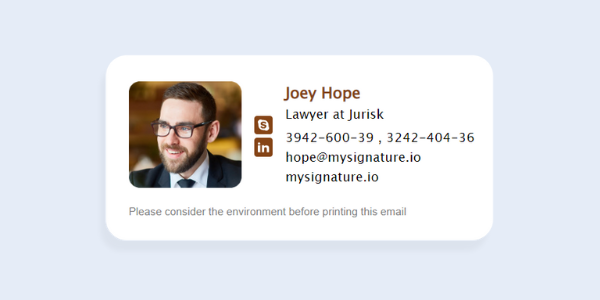
Name [your photo] + occupation + phone + skype + link to your portfolio
This template is suitable for you if you want a new job. Make sure to include a call to action by clicking the link to your portfolio.
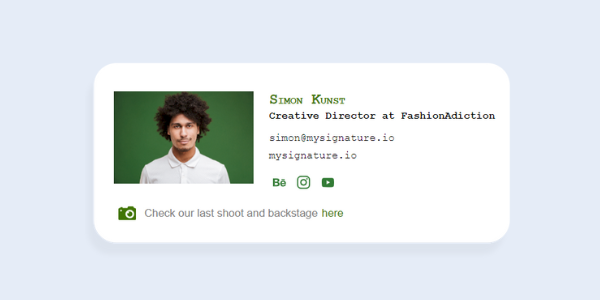
Full Name + phone + skype
A universal email template that may suit any situation.
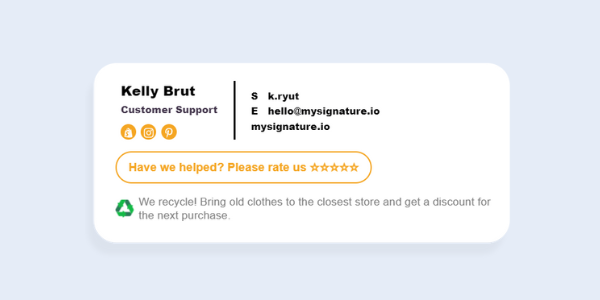
With MySignature, you can create any of the previously mentioned email sign-offs. They will look amazing because you have a chance to choose from a majority of professional templates, adjust colors, and add any custom elements based on your requirements.
Email Closing Phrases
Adjust the formality of your email ending based on the context. For professional settings, opt for formal closings, while informal endings work well for familiar relationships and help to make a good impression. So, here are some tips for ending an email.
- Use endings for emails expressing gratitude, especially those including variations of "thank you," as they show higher response rates, according to reports by Bloomberg.
- When concluding a job application email endings, it’s an important thing to maintain a balance between professionalism and enthusiasm. Phrases like "Looking forward to the opportunity" or "Eagerly awaiting your response" are good ways to end an email.
- Personalize your email ending by using the recipient's name at the End. This small touch adds warmth and establishes a connection, making your email more engaging.
- For emails where the tone falls between formal and informal, it’s better to use a general email sign-off like "Best" or "Kind Regards," which is often suitable.
- When initiating communication with a new contact, be polite and professional. Start an email to someone using greetings like "Dear [Name]" and consider a formal closing until a rapport is established.
- Remember that a good email starts with a compelling opening and ends with a memorable closing. Keep the balance between the tone set at the beginning and professional email closing.
Email Endings to Avoid
In communication, certain email sign-offs may undermine the tone you've worked hard to establish. That's why you should know how to end a professional email.
While a friendly tone is appreciated, overly informal sign-offs like "Catch ya later" or "Take care, dude" are not a good choice when you want to end an email professionally. Ending your email with vague phrases such as "Let me know" or "Keep in touch" without specifying the next steps can leave the recipient unsure of how to proceed.
Humor can be tricky to convey via email and may not always translate well. Jokes or sarcasm are email sign-offs to avoid if you don’t want to be misinterpreted by the recipient. While it's important to be polite, a sign-off that is excessively verbose or includes too many pleasantries can come across as insincere or disingenuous. Sometimes it’s better to use a word or short phrase.
Failing to include a clear closing statement or a call to action can leave the recipient feeling unresolved. Always aim to provide closure or a next step for further engagement.
By being mindful of these pitfalls, you can ensure that your email closings are professional, clear, and effective in communicating your message.

